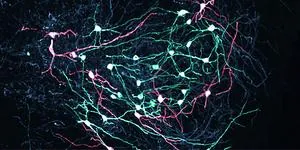
Unlocking the Secrets of Movement: The Brain's Precision Control Center
2025-05-28
Author: Li
Neuroscience Breakthrough: The Dual Role of Neurons
Researchers have unveiled a remarkable new understanding of how our brains orchestrate movement—not just by initiating actions, but also by suppressing them with remarkable accuracy. This groundbreaking study from the University of Basel and the Friedrich Miescher Institute for Biomedical Research, published in *Nature*, offers vital insights that could transform our approach to neurological disorders such as Parkinson's disease.
The Hidden Complexity of Everyday Actions
Whether you're reaching for a juicy apple or guiding a spoon to your mouth, these seemingly simple tasks involve intricate brain processes. At the heart of this complex orchestration is a brain region called the basal ganglia, traditionally thought to mainly function as a 'brake' on unwanted behaviors.
Redefining Movement Control
Under the leadership of Professor Silvia Arber, scientists exploring the basal ganglia have flipped this outdated model on its head. Their research on mice revealed that certain neurons here don’t just inhibit movement; they actively decide when to permit or prevent a specific motion. This dynamic decision-making governs the timing of our movements.
Basal Ganglia: The Brain's Control Hub
Focusing on the Substantia Nigra pars reticulata (SNr)—the basal ganglia's primary output station—the study uncovered a surprising finding: these neurons exhibit intricate activity patterns, perfectly synced to the movements performed. Think of it as a sophisticated traffic light system; each neuron turns 'green' or 'red' based on the planned action, allowing us to coordinate complex behaviors from individual movements.
Precision in Motion: A Closer Look at Neuronal Activity
To delve deeper, Arber's team monitored brain activity as mice used their paws to grab food pellets. They discovered that SNr neurons responded differently throughout each phase of movement—showing increased activity when the arm extended or the hand grasped while others paused. Lead authors Antonio Falasconi and Harsh Kanodia marveled at the precision: 'These signals are finely tuned, with SNr neurons pausing and activating based on specific movements.'
Manipulating Movement: The Power of Optogenetics
Employing optogenetic techniques, the researchers manipulated the SNr neurons and discovered that activating them effectively halted movement—emphasizing their critical control role. Strikingly, even the tiniest movement adjustments triggered precise changes in SNr signaling, creating a feedback loop with downstream motor centers. This interaction demonstrates a highly sophisticated coding system that goes beyond simple 'go' or 'stop' commands.
Implications for Movement Disorders: A Path to Treatment
This enlightening study not only reshapes our understanding of motor control but also carries significant medical implications. Disruptions in the delicate balance of activation and inhibition in the basal ganglia are at the heart of disorders like Parkinson’s disease, where sufferers struggle to initiate movement. 'By understanding the normal coordination of movements, we can develop targeted treatments for when this system falters,' explains Arber.



 Brasil (PT)
Brasil (PT)
 Canada (EN)
Canada (EN)
 Chile (ES)
Chile (ES)
 Česko (CS)
Česko (CS)
 대한민국 (KO)
대한민국 (KO)
 España (ES)
España (ES)
 France (FR)
France (FR)
 Hong Kong (EN)
Hong Kong (EN)
 Italia (IT)
Italia (IT)
 日本 (JA)
日本 (JA)
 Magyarország (HU)
Magyarország (HU)
 Norge (NO)
Norge (NO)
 Polska (PL)
Polska (PL)
 Schweiz (DE)
Schweiz (DE)
 Singapore (EN)
Singapore (EN)
 Sverige (SV)
Sverige (SV)
 Suomi (FI)
Suomi (FI)
 Türkiye (TR)
Türkiye (TR)
 الإمارات العربية المتحدة (AR)
الإمارات العربية المتحدة (AR)